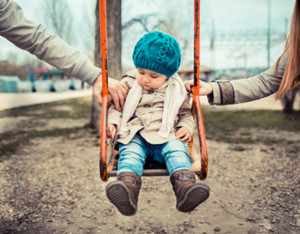 In November, North Dakota voters rejected the “Parental Rights Initiative,” which would have awarded equal parenting time to each parent following divorce or separation unless one parent was deemed unfit.
In November, North Dakota voters rejected the “Parental Rights Initiative,” which would have awarded equal parenting time to each parent following divorce or separation unless one parent was deemed unfit.
Although the initiative failed, it is emblematic of a movement over the past half century to involve both parents in the process of child rearing following divorce.
Last year, there were a number of developments regarding state child custody laws. Lawmakers in Arkansas passed a law calling for the “approximate and reasonable equal division of time” of children between parents during the divorce process. Maryland and Connecticut also created task forces and commissions to examine child custody issues.
Unfortunately, inequalities in child custody statutes still remain.
As custody laws continue to evolve, it’s important to look back on the history of child custody in the U.S. to understand how we got to this point, where we are now, and where we might be going in regards to child custody issues.
Child custody in Colonial America
When colonial Americans settled in the U.S., they followed English common law that granted the father custody of children following divorce.
But with the rise of the Industrial Revolution, more fathers began leaving their farms and villages for work, leaving mothers behind to take care of the kids. This is where the image of fathers as wage earners and mothers as caregivers began to emerge and influence custody decisions.
In 1839, England enacted the Custody of Infants Act, which allowed the judge to use his own discretion in custody cases. The act permitted a mother to petition courts for custody of her children up to the age of 7.
In 1873, Parliament extended the age to 16 under the “Tender Years Doctrine,” which presumed that in a child’s early years, they are best cared for by the mother. This principle was adopted by the majority of U.S. states and the law reigned for the next century.
“Best interest of the child”
As divorce rates began surging in the 1960s and the following decades, a new debate emerged about the parental roles of each parent. Father’s rights groups grew more prevalent, which gave rise to a movement for gender equality.
Eventually, the Tender Years Doctrine was replaced by a more inclusive, but more vague, “best interest of the child” standard. This granted judges an extraordinary amount of discretion in determining what was in a child’s best interests when determining custody. It also opened the door to bitterly contested custody battles.
The rise of the best interest standard also led to the birth of joint custody in which parents began sharing custody of their children. This was aided by a couple cultural developments.
First, in the 1970s the child development field began paying more attention to the important contributions fathers can make in a child’s development. Second, family gender roles started shifting with more women joining the workforce.
In 1979, California passed the first joint custody statute. By 1991, more than 40 states had statues with joint custody as an option or preference.
Child custody norms have changed dramatically in the years since. One of the largest surveys of child custody cases, which looked at court-ordered placement arrangements in Wisconsin between 1996 and 2007, shows that the percentage of divorce cases in which the mother was granted sole custody fell from 60.4 to 45.7 percent while the percentage of equal shared custody cases nearly doubled.
Flaws remain
Until recently, nearly all child custody was divided into custodial and non-custodial with the custodial parent receiving custody the majority of the time and the non-custodial parent only receiving visitation.
Now, most arrangements are joint physical and legal custody with both parents receiving parenting time with their children.
Although progress has been made, massive flaws still remain in the country’s child custody laws.
Many of these problems were summarized in the National Parents Organization’s comprehensive Shared Parenting Report Card that was released in November. The report card, which was the first of its kind, graded each state based on its child custody statutes.
Sadly, nearly across the board, states scored poorly with a cumulative grade point average of 1.63 (calculated on a 4.0 scale).
Even a state such as Wisconsin, which on the surface seems to be doing a decent job of promoting shared custody, still has critical shortcomings in its statutes.
For example, even though the state’s laws presume that joint legal custody is in the child’s best interest, there is still no statutory preference for shared physical custody for temporary or final orders and the statutes fail to explicitly provide for shared parenting during temporary or final orders.
While the days of a mother or father almost exclusively receiving sole custody are in the past, it is clear that there is still much work to be done before truly equal child custody laws are established.



Does anyone know where a more descriptive account for this information can be found? This seemed very vague and overly optimistic. From personal experience, I’ve only seen a system that defers child custody to women. A man trying to fight it and get custody of his child or children can be stopped in his attempt with only one accusation of abuse, of any kind. The system will not think twice about denying him custody. And the child support is so high, a courts version of reasonable child support is reduced child support only by an amount that is being paid for the child in another way. For one child support case I’m paying $375 a month. I got a $160 deduction so I could pay $160 for medical insurance. So I’m still paying $375. My other child support case is $387. So out of the $1440 I get to live on from my paycheck, $762 is child support and I have $678 to live on. That’s rent and gas to get back and forth from work. I work a swing shift so another job isn’t optional, I’m a supervisor and a promotion isn’t optional yet. This information is vital I believe in pointing out past mistakes and vaguely summarizing them only makes it more like that parental equality will remain a myth.
Actually, if you want more informative info, there is a book called Mother on Trial ; the battle for childrn and custody by Phyllis Chesler that has the truth of the matter in it. You believe myths and stereotypes. The truth is somewhere around 80% of fathers succeed in court whether it be sole custody of increased custody time, 80%. That is alot. Yet they use statistics that include all the dads that never even ask for custody to say the percentage of moms that get custody. In custody BATTLES is the key, not just custody in general. There are many reasons women usually have custody: men don’t know what they would do with kids alone, men don’t want to seperate their children from their mothers because they really do love their children, and then some just think that is how it is done still, some think they would not have a chance because they believe the media making court seemed weighted for the mom. It isnt . I am living breathing proof. Abusers only have to say that their ex is brainwashing the kids against them and trying to seperate a good dad from his kids and they will remove them from mom completely. In my case my ex and his mistress turned wife brainwashed my kids and then had them sign elections at 14. My daughters were 15, 14, and 10, she got to go by proxy. I havent held them in 5.5 years. I have attempted every single legal remedy, and I am thwarted at each turn, i cant live my life without my kids in it, i feel dead, but they dont care, my kids are being led by idiots who have taught them how to lie in court and manipulate their way through life, and they dont see anything wrong with it. I didnt mean to name call either, i was only describing their lower level of intellegence. They never cared what was best for them, they let them do whatever they want, as long as it doesnt cost them money, they didnt care if they dropped out if hs. The whole thing was to turn the tables on cs, so now they want me in jail, when i never reported him for arrears. Mothers have to live with this stigma that only bad moms lose their kids. It isnt true. Noone knows until it happens to them. Walk in my shoes. On top of it all, you lose your pride. They take it from you. You know you were the only one who gave a shit about them and now you cant even talk to them, or they think daddy wont love them. And they have a little sister who doesnt understand and misses them every day. She deserved to have her sisters. They corrupted their minds. They will no longer value family
The reason fathers in colonial times received custody of children is because they were considered property. A mother, literally, had no right legally speaking in that era and culture at all. Women are still at a considerable disadvantage.
A lot of the problems around custody are cultural rather than legal. I’d appreciate if you cited your article.
The bottom line is that in the MAJORITY of cases a 50-50 split does not benefit the child. Child’s needsband best interest do need to supercede parental rights.
I once wrote a paper in law school titled BLACKSTONE AND THE GREAT AMERICAN WELFARE SYSTEM. I remember that back in Blackstone’s day, wives and children were considered the property of the husband/father. I’m sure divorce wasn’t common because women got nothing from such a legal fiasco. Further, if both were considered legal property, divorce would have been impossible. When divorce with cause became marginally acceptable, it was clear that the courts maintained continuous jurisdiction over the children of that marriage until they reached the age of majority. This was done for their protection. Once in the domestic relations courtroom, you stay until you were 21. Today it’s 18. There are clearly many instances where fathers should be the custodial parent, but the courts keep deferring to mothers who no longer resemble Donna Reed or Mrs. Cleaver. In fact, many have become a bit hardened and often spend little time with their children. This has given an opportunity for dads to assert what was taken from them without appropriate consideration for the needs of the children. Hope this helps.
First of all, I appreciated the brief summation on the history of child custody here in the United States; I did not know about the fathers gaining custody back then. It does make sense why more woman were gaining custody during the industrial revolution when the men would leave so often for work. It’s good to read that, although flaws remain, that more equality is being brought to these situations that can be very delicate and sensitive. Thank you for your informative post.